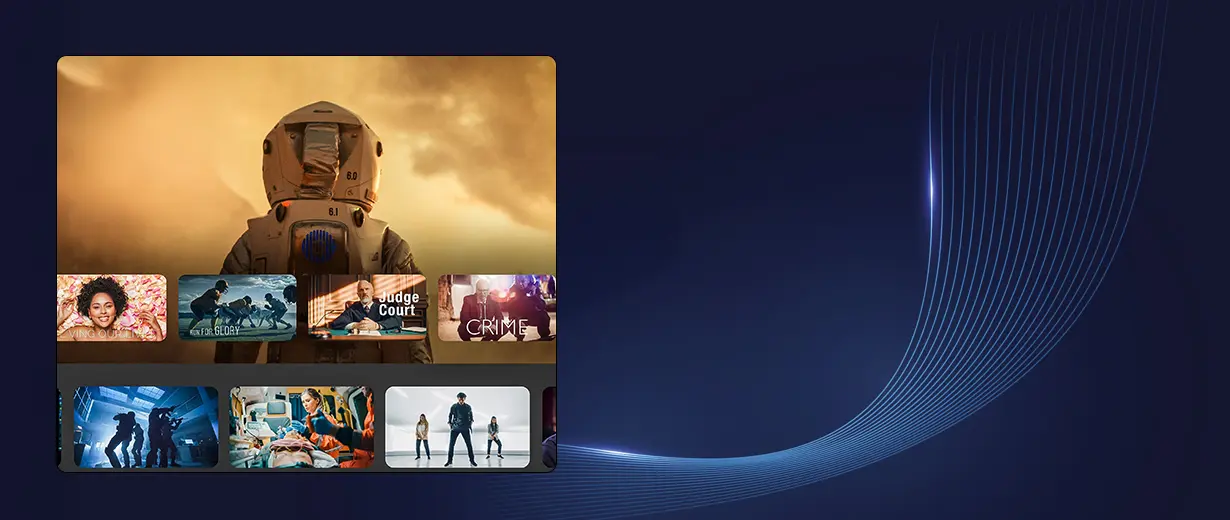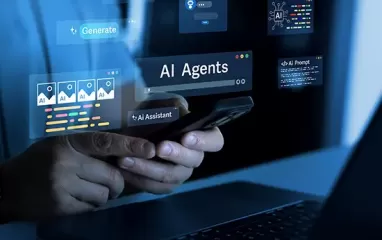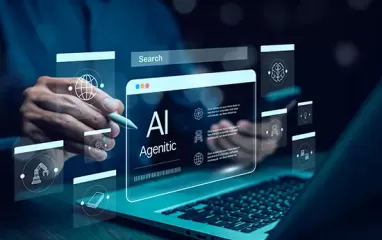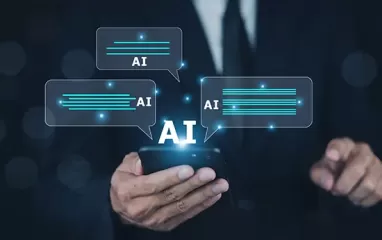Other recent blogs



Let's talk
Reach out, we'd love to hear from you!
The streaming wars are no longer just about content libraries and pricing strategies. In 2025, we're witnessing a seismic shift in which Generative AI isn't just enhancing OTT platforms—it's fundamentally rewriting the rules of how content is created, managed, and consumed. While most discussions focus on recommendation algorithms, the real transformation lies in the backend infrastructure that makes modern streaming possible.
The OTT landscape has evolved far beyond simple content delivery. With the global OTT market projected to reach $595 billion by 2030, growing at a CAGR of 16.7%, we're seeing a fundamental shift in how platforms operate. The traditional model of content acquisition and linear distribution is giving way to something far more dynamic and intelligent.
What's particularly fascinating is the emergence of what industry insiders call "streaming fatigue," a phenomenon in which households are beginning to consolidate their subscriptions. According to recent forecasts, the number of streaming subscriptions per household will peak at four services in the US and just over two in Europe by 2025 and then decline. This consolidation pressure is forcing platforms to become more sophisticated in their approach to content management and user engagement.
The GenAI revolution in Video OTT platforms: From recommendation to orchestration
The impact of GenAI on OTT platforms extends far beyond the commonly discussed recommendation engines. While predictive analytics for content demand remains crucial, the real revolution is happening in three distinct layers:
- Content creation: GenAI enables the creation of personalized content at a large scale. By 2025, AI-generated short films and interactive narratives that adapt to viewer preferences in real-time are becoming standard offerings. This isn't just about efficiency—it's about creating content that literally couldn't exist without AI.
- Operational intelligence: The most significant transformation is occurring in how platforms manage their vast content ecosystems. GenAI is revolutionizing content ingestion, metadata generation, and cross-platform distribution workflows. Platforms are reporting up to 40% reduction in content packaging time and 80% improvement in cross-system data gathering.
- Experience orchestration: Beyond recommendations, GenAI is enabling dynamic content assembly where storylines, advertisements, and even UI elements are generated on-demand based on real-time user behavior analysis.
The AI-driven custom OTT CMS: The invisible game-changer in the entertainment industry
The most underestimated transformation in OTT is happening in Content Management Systems. Traditional CMS platforms were designed for static workflows and predetermined content structures. Today's AI-driven custom CMS represents a paradigm shift from content storage to content intelligence.
An AI-driven custom OTT CMS operates on a fundamentally different principle: instead of storing content in rigid hierarchies, it creates dynamic content relationships that evolve based on usage patterns, performance metrics, and predictive modeling. This isn't just about better organization—it's about creating a system that understands content at a semantic level.
The system transforms from a passive repository into an active participant in content strategy. When a content manager uploads a new series, the AI-driven CMS doesn't just store it—it analyzes narrative structure, identifies similar content, predicts audience segments, suggests optimal release schedules, and even generates marketing assets.
A truly intelligent OTT CMS in 2025 must operate beyond traditional content management paradigms. Here's the checklist of core functionalities to look for in the innovative video OTT CMS:
- Dynamic content intelligence: The system should feature custom prompt templates that can extract structured parameters from unstructured content data. This means automatically generating comprehensive metadata, identifying content themes, and creating semantic relationships between different pieces of content.
- Adaptive response architecture: Modern systems require sophisticated JSON parsing of LLM outputs combined with switch-case routing logic that can call the correct backend functions based on content analysis. This enables the system to make autonomous decisions about content processing workflows.
- Intelligent content synthesis: The platform must be capable of prompt-based HTML summarization that adapts to data volume, creating detailed breakdowns for complex content and concise overviews for simpler material.
- Universal search capabilities: Beyond traditional keyword search, the system should enable global semantic search that understands context, intent, and content relationships across multiple data types and formats.
- Modular content architecture: The ability to fetch and analyze specific widgets and containers, extracting detailed insights about content performance, user interaction patterns, and optimization opportunities.
The modern AI OTT CMS Stack: Choosing the right technical architecture
Building a truly intelligent OTT CMS requires careful consideration of the underlying technology stack that can support both current demands and future scalability. The most sophisticated platforms today are adopting API-first architectures that prioritize flexibility, performance, and seamless integration capabilities.
At the foundation of the AI-first architecture lies Node.js because of its non-blocking I/O operations and event-driven architecture that excels in handling the concurrent requests typical of content management workflows.
Next comes the user interface layer that reflects a fundamental shift from traditional form-based content management to conversational interfaces powered by React.js. With sophisticated chat interfaces, it becomes easier to maintain the OTT platform performance for real-time content preview.
The AI-centered platform is incomplete without the intelligence layer integration. Through OpenAI SDK, the most significant architectural decision in modern CMS development can be achieved. The direct GPT-4 integration enables sophisticated content analysis capabilities beyond simple keyword extraction while identifying thematic elements, generating compelling descriptions, and optimal content categorization based on semantic analysis.
Custom OTT CMS Development: The hidden challenges beyond technical implementation and the solutions
Developing a custom OTT CMS presents unique challenges that extend far beyond traditional software development. The primary challenge isn't technical—it's conceptual. Organizations must fundamentally rethink their relationship with content, moving from ownership models to stewardship models.

1. The multi-platform adaptive transcoding
Managing terabytes of video content across multiple platforms isn't just about storage—it's about intelligent transcoding and adaptive bitrate streaming. A single piece of content might need to exist in 15+ different formats: H.264 and H.265 codecs, multiple resolutions (480p to 4K), various bitrates for different network conditions, and platform-specific optimizations.
- Technical Reality: The CMS must orchestrate complex transcoding workflows using tools like FFmpeg, but at scale, this becomes a distributed computing problem. You're dealing with Docker containers running transcoding jobs across Kubernetes clusters, managing job queues with Redis, and coordinating file system operations across distributed storage systems like AWS S3 or Google Cloud Storage.
- Hidden Challenge: When you discover that your content performance metrics are misleading because your CMS isn't accounting for device-specific viewing patterns. A series might perform excellently on mobile devices but poorly on smart TVs, not because of content quality, but because of adaptive bitrate algorithm differences. Smart TV processors handle H.265 decoding differently than mobile chips, and your CMS needs to understand these nuances.
- The Fix: You end up rebuilding your content optimization algorithms to account for device-specific variables—implementing machine learning models that can predict optimal encoding parameters based on device capabilities, network conditions, and user behavior patterns. This requires integrating TensorFlow or PyTorch models directly into your content processing pipeline.
2. The multi-system data consistency
Modern OTT platforms operate across dozens of different systems—from content management to user analytics to billing systems. Creating a unified intelligence layer requires sophisticated data harmonization and interpretation capabilities that go far beyond traditional ETL processes.
- Technical Reality: The content management system shows high engagement for a series, your analytics platform reports declining viewership, and your billing system indicates subscription cancellations. The problem isn't with the data—it's with how different systems define "engagement," "viewership," and "content-related churn." Each system has its own timestamp formats (Unix timestamps vs. ISO 8601), user identification methods (UUID vs. email-based), and measurement criteria.
- Hidden Challenge: Implementing data consistency requires building a sophisticated data mesh architecture. You need real-time data synchronization between PostgreSQL databases, Elasticsearch clusters for search functionality, and ClickHouse for analytics. The challenge is maintaining ACID properties across distributed systems while ensuring low-latency data access.
- The Fix: The solution involves implementing saga patterns for distributed transactions, using Apache Airflow for data pipeline orchestration, and building custom data validation services that can detect and resolve schema inconsistencies.
3. The non-linear content lifecycle
OTT content doesn’t follow a straight path. A title may exist as a director’s cut, regional edit, and promo—all active at once. Updating metadata in one version can unintentionally affect others, causing conflicts. Solving this means building Git-like version control for media: using Merkle trees for relationship tracking, content-addressable storage for deduplication, and distributed locks to manage concurrent edits. The system must support branching, merging, and resolving metadata conflicts in real time.
- Technical Reality: The same content exists in multiple states simultaneously—director's cuts, international versions, censored versions for different markets, and behind-the-scenes content. When you update metadata for one version, it cascades changes across all versions, creating inconsistencies that require manual resolution.
- Hidden Challenge: This requires implementing a sophisticated content version control system similar to Git but optimized for large media files. You're looking at building a content versioning system using blockchain-inspired Merkle trees to track content relationships, combined with content-addressable storage to prevent duplication.
- The Fix: The technical architecture needs to support branching and merging of content versions, conflict resolution algorithms for metadata updates, and distributed locks to prevent race conditions during simultaneous edits. This involves implementing custom consensus algorithms and using distributed storage systems like IPFS for content deduplication.
4. The real-time decision engine
OTT platforms need to make thousands of decisions per second about content delivery, quality optimization, and user experience personalization. Traditional CMS architectures weren't designed for this level of real-time intelligence.
- Technical Reality: During traffic spikes, your CMS can't adapt quickly enough to changing usage patterns, leading to suboptimal content delivery. Popular content loads slowly while less popular content streams perfectly. The system needs to learn and adapt in real-time, but traditional CMS architectures require manual intervention to adjust content prioritization algorithms.
- Hidden Challenge: Implementation of streaming analytics with Apache Kafka and Apache Flink is needed for real-time data processing. Machine learning models that can predict content demand patterns and automatically adjust CDN caching strategies. This involves implementing reinforcement learning algorithms that can optimize content delivery decisions based on real-time feedback.
- The Fix: The technical architecture requires event-driven microservices communicating through message queues, with circuit breakers and bulkhead patterns to prevent cascade failures. You're dealing with eventually consistent systems where data might be temporarily out of sync, requiring sophisticated conflict resolution mechanisms.
5. The content creator integration
Modern OTT platforms work with hundreds of content creators, each with different workflows, technical capabilities, and creative requirements. The CMS must accommodate this diversity while maintaining quality standards.
- Technical Reality: Different creators use different video formats (ProRes, DNxHD, H.264), metadata standards (Dublin Core, SMPTE), and delivery methods (FTP, cloud storage, API uploads). The CMS can't intelligently normalize these inputs, leading to manual processing bottlenecks.
- Hidden Challenge: The solution requires building a content ingestion pipeline that can handle multiple input formats and automatically normalize them. This involves implementing Apache NiFi for data flow management, custom parsers for different metadata formats, and machine learning models for automatic content categorization.
- The Fix: You need to build APIs that can adapt to different creator workflows while maintaining data quality. This requires implementing schema validation, content fingerprinting for duplicate detection, and automated quality assurance checks using computer vision models.
The Kellton approach for measurable transformation: Quantifiable business impact
The practical impact of intelligent OTT CMS implementation can be measured across multiple dimensions. Organizations implementing these systems are seeing remarkable improvements in operational efficiency and content performance.
- Operational efficiency gains: Content ingestion and packaging processes are being streamlined by up to 40%, with intelligent automation handling routine tasks and flagging exceptions for human review. This isn't just about speed—it's about accuracy and consistency in content processing.
- Self-service capabilities: The transformation to conversational interfaces is enabling operators, QA teams, and product managers to access complex data insights without technical intervention. This democratization of data access is reducing bottlenecks and enabling faster decision-making across the organization.
- API optimization: Intelligent routing systems prevent redundant backend calls, optimize API usage, and reduce system load. This intelligent load management is crucial for maintaining performance as content libraries and user bases scale.
- Cross-functional accessibility: The unified interface approach enables different teams to access the same data through role-appropriate interfaces, ensuring consistency while maintaining security and access control.
- Data integration acceleration: The ability to gather cross-system data through a single AI interface is reducing data collection time by up to 80%, enabling real-time insights that weren't previously possible.
- System consistency: Creating a single source of response for data interpretation across different systems ensures consistent decision-making and reduces the risk of conflicting insights.
- Technical independence: By reducing dependency on technical teams for routine data gathering, content and operations teams can focus on strategic initiatives rather than operational tasks.
The future landscape of AI OTT CMS beyond 2025
The transformation we're witnessing in 2025 is just the beginning. The convergence of GenAI with OTT platforms is creating possibilities that were unimaginable just a few years ago. We're moving toward a future where content creation, distribution, and consumption become seamlessly integrated through intelligent systems.
The platforms that will dominate the next decade won't just be those with the best content libraries—they'll be those with the most sophisticated content intelligence. The ability to understand, predict, and adapt to changing user preferences in real-time will become the ultimate competitive advantage.
The evolution from traditional content management to intelligent content orchestration represents more than a technological upgrade—it's a fundamental shift in how we think about media, entertainment, and user engagement. The organizations that embrace this transformation early will be positioned to lead the next phase of the streaming revolution.
As we look beyond 2025, the distinction between content creators and content platforms will continue to blur. GenAI-driven systems will enable every platform to become a content creator, and every piece of content to become a platform for deeper engagement. The future of OTT isn't just about watching content—it's about interacting with intelligent media ecosystems that understand and respond to individual user needs in real-time.
The revolution is already underway. The question isn't whether GenAI will reshape the OTT industry, but how quickly organizations can adapt to this new reality and harness its transformative potential.



